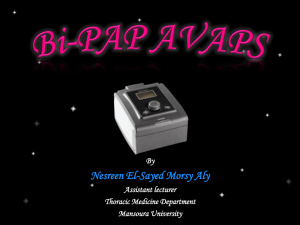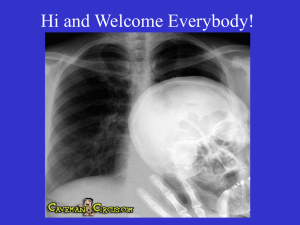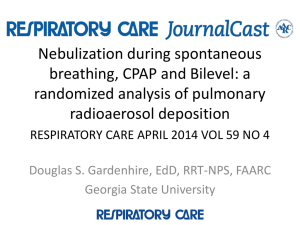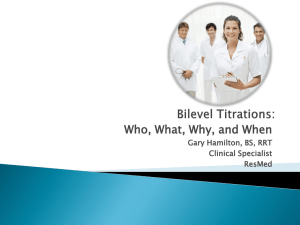Respironics BiPAP
advertisement
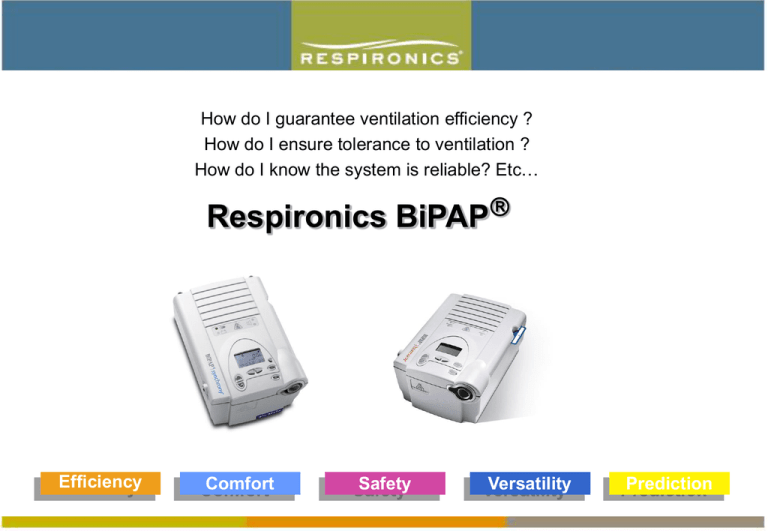
How do I guarantee ventilation efficiency ? How do I ensure tolerance to ventilation ? How do I know the system is reliable? Etc… Respironics BiPAP Efficiency Comfort Safety Versatility Prediction How do I achieve an optimised patient/ventilator Synchronisation? How do I guarantee ventilation Efficiency? Respironics Technology and Know How Efficiency Comfort Safety Versatility Prediction Respironics Technology and Know-How AVAPSTM ⇨ Late 80’s, Respironics first introduced BiPAP technology and Auto-TRAK Algorithm for better patient/ventilator synchronization • Chest 1997 : “Performance Characteristics of Bilevel Pressure Ventilators” • AJRCCM 2001 : “Noninvasive Ventilator Triggering in Chronic Obstructive Pulmonary Disease” • Chest 2005 : “Performance Characteristics of 10 Home Mechanical Ventilators in PressureSupport Mode” ⇨ 2003: Respironics introduced AVAPS for improved ventilation comfort and efficiency without compromise Respironics BiPAP Technology Respironics BiPAP Blower only Blower works at a constant speed The blower inertia does not affect patient ventilation The valve controls the flow provided by the blower Response time close to 0 : able to provide high patient breath rate and high rise time, short fall time Flow Responds to extra flow demand (225LPM at 25cmH2O) Compensates for most leaks Reduces respiratory work Pressure Blower Air Filter Patient Circuit Airflow Sensor Exhaust Proportional Valve Ambient Air Respironics BiPAP Ventilators BiPAP Harmony and BiPAP Synchrony Same Platform: ‐ Integrated heated humidifier ‐ SmartCard ‐ Compatible with both Encore Pro software and Stardust II polygraph ‐ Small and light: • 1,8 Kg • 24 x 17 x 11 = 4,5 L 250 200 Flow (LPM) Same Technology: BiPAP ‐ Blower works at a constant speed ‐ The valve controls the flow provided by the blower ‐ Digital Auto-TRAK Sensitivity 150 100 50 0 24 25 26 27 28 Pressure (cmH2O) 29 30 « Unlike manually controlled triggers, Auto-TRAK does the work for you » Characteristics ‐ Automatic inspiratory trigger and expiratory cycle ‐ Leak compensation over 60LPM ‐ Leak estimation to calculate Vte at 15% accuracy Advantages ‐ Efficient Ventilation: Leaks are all compensated. Trigger thresholds automatically adjust according to the changes in leaks and patient respiratory mechanics ‐ Easy Ventilation: No trigger adjustments are required ‐ Safe Ventilation: Alarms & monitoring of Vte, MinVent Digital Auto-TRAK Algorithm ‐ ‐ Inspiration: when the patient makes an effort to inspire, the flow naturally increases Expiration: when the patient makes an effort to expire, the flow naturally decreases Flow Shape signal: Delayed waveform crossing patient flow in case of flow direction changes Detects an accumulated 6ml volume above the base line Digital Auto-TRAK Algorithm ‐ Spontaneous Expiratory Threshold: electronic signals that rises in proportion of tidal volume ‐ Flow Reversal: allows detection of excessive mouth leak. If the flow increases by more than 10% of the peak flow in a short period of time then switch to EPAP ‐ Safety Feature: inspiratory time cannot exceed 3 seconds Digital Auto-TRAKTM Sensitivity « A proven technology » “Patient-ventilator synchrony is a key to the success of long-term Home NIV as dysynchrony causes patient intolerance” Chest 2005 : “Performance Characteristics of 10 Home Mechanical Ventilators in PressureSupport Mode” How do I set ventilation parameters? How do I adapt settings to patients’ needs? Ventilation Modes & Settings Efficiency Comfort Safety Versatility Prediction « The management strategy is based on an individualized assessment of disease severity and response to various therapies. » Source: Global Strategy for the Diagnosis, Management, and Prevention of Chronic Obstructive Pulmonary Disease GOLD scientific committee - NHLBI/WHO workshop summary - AJRCCM 2001 Therapy depends upon the patient’s pathology type and severity BiPAP Synchrony / BiPAP Harmony Features Synchrony Harmony CPAP – S – S/T – PC – T AVAPS Pressure up to 30 cmH2O CPAP – S – S/T Pressure up to 30 cmH2O Monitoring Pressure MinVent – Vte – RR – Leak Pressure Alarms Apnea Disconnection Low minute ventilation Low tidal volume (AVAPS) Apnea Disconnection Encore Pro / Stardust II / SmartCard Integrated Humidifier Battery (7hrs autonomy at 20/4 cmH2O) Encore Pro / Stardust II / SmartCard Integrated Humidifier Battery (7hrs autonomy at 20/4 cmH2O) Modes Tools Operational Characteristics Modes Description Patient inspiratory and expiratory efforts Pressure IPAP Ti Patient Spontaneous EPAP T Pressure IPAP Spontaneous Timed EPAP S Ti Patient 60/RR T Ti Machine S Ti Patient Ti max T Operational Characteristics Mode Description Pressure IPAP Ti Machine Ti Machine Ti Machine Timed EPAP T Pressure IPAP Ti Machine Pressure Control Ti Machine Ti Machine EPAP 60/RR T Respironics Ventilation Modes S mode S/T mode P/C mode T mode IPAP EPAP Spontaneous breaths IPAP EPAP RR Ti Spontaneous breaths with back up respiratory rate IPAP EPAP RR Ti Ti fixed for every breath Patient can trigger to inspiration IPAP EPAP RR Ti Each breath is controlled AVAPSTM Feature Variation of 1cmH2O maximum per minute PS ± ΔP PS Ensure Averaged Vt AVAPS available on S, S/T, PC and T modes IPAP automatically adjusts from breath to breath to ensure an averaged Vt Settings: IPAPmin, IPAPmax and Target Vt AVAPSTM Suggested Settings AVAPS Settings 1. Set the Target Tidal Volume To the displayed patient tidal volume when ventilated on S/T mode or To 8ml/kg of ideal weight and adjust depending on pathology, patient tolerance and clinical outcome 2. Set IPAP Limits IPAP max = 25 to 30 cmH2O depending on patient pathology and IPAP min = EPAP + 4 cmH2O Synchrony Screen Respironics Alarms Disconnection: OFF, 15, 60 sec. ‐ High flow rate and small pressure Low minute Ventilation: from 0 to 99 LPM Apnea alarm: OFF, 10, 20, 30 sec. Low tidal Volume (AVAPS only): OFF (0) / ON (1) ‐ When the target tidal volume is not reached whereas the IPAP is at the set IPAP max level Efficiency Comfort Safety Versatility Prediction Battery Pack for Portable Use & Increased Safety Can be connected to all our BiPAP Universal battery charger 100/240V for ease of travel 7hrs autonomy at IPAP 20 / EPAP 4 cmH2O and 12 BPM with BiPAP Harmony & BiPAP Synchrony Efficiency Comfort Safety Versatility Prediction Easily Set the Ventilation on our BiPAP Palm Pilot remote control SleepLink BiPAP Harmony BiPAP Synchrony Computer with PC Direct software Easily Set the Ventilation on our BiPAP Palm Pilot remote Control PC Direct Software Patient’s Follow Up Maintain an efficient Ventilation and avoid exacerbation episodes Get all details on patient’s ventilation Frequently check therapy efficiency Detect abnormal respiratory patterns Adjust settings Efficiency Comfort Safety Versatility Prediction 100% fit,100% of the time Optimize comfort and drive therapy acceptance of new patients Replaces silicone masks of patients already on therapy A solution to mouth breathers and acute NIV patients Smaller and lighter masks for patients who are looking for comfortable alternatives. Comfort with Style. Efficiency Comfort Prediction Safety Versatility BiPAP Harmony Digital Auto-TRAK Algorithm BiPAP Technology Encore Pro Compact & light Integrated Humidifier Stardust II Battery Pack BiPAP Synchrony (featuring AVAPS) Digital Auto-TRAK Algorithm BiPAP Technology Compact & light Integrated Humidifier Encore Pro Stardust II Patient alarms & monitoring Ventilation modes & settings Battery Pack AVAPS support function
